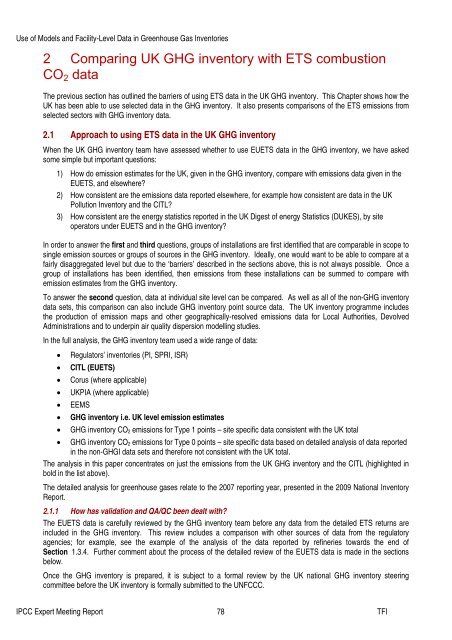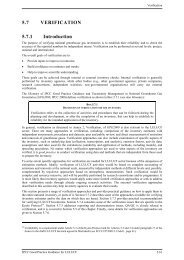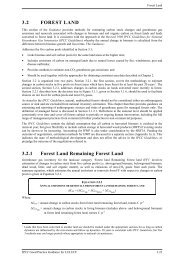Use of Models and Facility-Level Data in Greenhouse Gas Inventories
Use of Models and Facility-Level Data in Greenhouse Gas Inventories
Use of Models and Facility-Level Data in Greenhouse Gas Inventories
Create successful ePaper yourself
Turn your PDF publications into a flip-book with our unique Google optimized e-Paper software.
<strong>Use</strong> <strong>of</strong> <strong>Models</strong> <strong>and</strong> <strong>Facility</strong>-<strong>Level</strong> <strong>Data</strong> <strong>in</strong> <strong>Greenhouse</strong> <strong>Gas</strong> <strong>Inventories</strong><br />
2 Compar<strong>in</strong>g UK GHG <strong>in</strong>ventory with ETS combustion<br />
CO 2 data<br />
The previous section has outl<strong>in</strong>ed the barriers <strong>of</strong> us<strong>in</strong>g ETS data <strong>in</strong> the UK GHG <strong>in</strong>ventory. This Chapter shows how the<br />
UK has been able to use selected data <strong>in</strong> the GHG <strong>in</strong>ventory. It also presents comparisons <strong>of</strong> the ETS emissions from<br />
selected sectors with GHG <strong>in</strong>ventory data.<br />
2.1 Approach to us<strong>in</strong>g ETS data <strong>in</strong> the UK GHG <strong>in</strong>ventory<br />
When the UK GHG <strong>in</strong>ventory team have assessed whether to use EUETS data <strong>in</strong> the GHG <strong>in</strong>ventory, we have asked<br />
some simple but important questions:<br />
1) How do emission estimates for the UK, given <strong>in</strong> the GHG <strong>in</strong>ventory, compare with emissions data given <strong>in</strong> the<br />
EUETS, <strong>and</strong> elsewhere?<br />
2) How consistent are the emissions data reported elsewhere, for example how consistent are data <strong>in</strong> the UK<br />
Pollution Inventory <strong>and</strong> the CITL?<br />
3) How consistent are the energy statistics reported <strong>in</strong> the UK Digest <strong>of</strong> energy Statistics (DUKES), by site<br />
operators under EUETS <strong>and</strong> <strong>in</strong> the GHG <strong>in</strong>ventory?<br />
In order to answer the first <strong>and</strong> third questions, groups <strong>of</strong> <strong>in</strong>stallations are first identified that are comparable <strong>in</strong> scope to<br />
s<strong>in</strong>gle emission sources or groups <strong>of</strong> sources <strong>in</strong> the GHG <strong>in</strong>ventory. Ideally, one would want to be able to compare at a<br />
fairly disaggregated level but due to the ‘barriers’ described <strong>in</strong> the sections above, this is not always possible. Once a<br />
group <strong>of</strong> <strong>in</strong>stallations has been identified, then emissions from these <strong>in</strong>stallations can be summed to compare with<br />
emission estimates from the GHG <strong>in</strong>ventory.<br />
To answer the second question, data at <strong>in</strong>dividual site level can be compared. As well as all <strong>of</strong> the non-GHG <strong>in</strong>ventory<br />
data sets, this comparison can also <strong>in</strong>clude GHG <strong>in</strong>ventory po<strong>in</strong>t source data. The UK <strong>in</strong>ventory programme <strong>in</strong>cludes<br />
the production <strong>of</strong> emission maps <strong>and</strong> other geographically-resolved emissions data for Local Authorities, Devolved<br />
Adm<strong>in</strong>istrations <strong>and</strong> to underp<strong>in</strong> air quality dispersion modell<strong>in</strong>g studies.<br />
In the full analysis, the GHG <strong>in</strong>ventory team used a wide range <strong>of</strong> data:<br />
• Regulators’ <strong>in</strong>ventories (PI, SPRI, ISR)<br />
• CITL (EUETS)<br />
• Corus (where applicable)<br />
• UKPIA (where applicable)<br />
• EEMS<br />
• GHG <strong>in</strong>ventory i.e. UK level emission estimates<br />
• GHG <strong>in</strong>ventory CO 2 emissions for Type 1 po<strong>in</strong>ts – site specific data consistent with the UK total<br />
• GHG <strong>in</strong>ventory CO 2 emissions for Type 0 po<strong>in</strong>ts – site specific data based on detailed analysis <strong>of</strong> data reported<br />
<strong>in</strong> the non-GHGI data sets <strong>and</strong> therefore not consistent with the UK total.<br />
The analysis <strong>in</strong> this paper concentrates on just the emissions from the UK GHG <strong>in</strong>ventory <strong>and</strong> the CITL (highlighted <strong>in</strong><br />
bold <strong>in</strong> the list above).<br />
The detailed analysis for greenhouse gases relate to the 2007 report<strong>in</strong>g year, presented <strong>in</strong> the 2009 National Inventory<br />
Report.<br />
2.1.1 How has validation <strong>and</strong> QA/QC been dealt with?<br />
The EUETS data is carefully reviewed by the GHG <strong>in</strong>ventory team before any data from the detailed ETS returns are<br />
<strong>in</strong>cluded <strong>in</strong> the GHG <strong>in</strong>ventory. This review <strong>in</strong>cludes a comparison with other sources <strong>of</strong> data from the regulatory<br />
agencies; for example, see the example <strong>of</strong> the analysis <strong>of</strong> the data reported by ref<strong>in</strong>eries towards the end <strong>of</strong><br />
Section 1.3.4. Further comment about the process <strong>of</strong> the detailed review <strong>of</strong> the EUETS data is made <strong>in</strong> the sections<br />
below.<br />
Once the GHG <strong>in</strong>ventory is prepared, it is subject to a formal review by the UK national GHG <strong>in</strong>ventory steer<strong>in</strong>g<br />
committee before the UK <strong>in</strong>ventory is formally submitted to the UNFCCC.<br />
IPCC Expert Meet<strong>in</strong>g Report 78 TFI

















